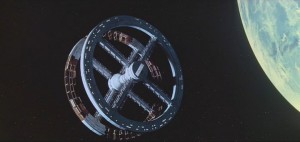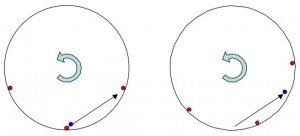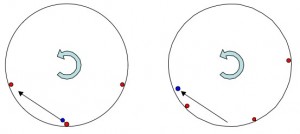Physicist: Normal gravity on Earth, , never changes. However, the acceleration,
, due to centrifugal force on the station is given by
, where
is how fast the station is spinning, and R is the radius of the station. If you’re sitting still or walking slowly on a space station, then you’d probably never notice the difference, but if you run either with or against the direction of spin you can change the value of
(for yourself), and thus change the amount of centrifugal force you experience. Whether or not you notice a difference now depends on how big the station is.

Kick-ass, spinning space station (from "2001")
The acceleration, due to gravity on the surface of the Earth is about , and I would guess that a
change in your weight is generally detectable. Given this
estimate, a running speed of around
(10 mph), and assuming that the station is spinning exactly fast enough to have
, then, after some math happens, you’ll find that when the radius of the station is less than around 3.25 km that you can detect the difference. So, you could tell the difference on any ship or station likely to be made in this solar system at least.
If you don’t feel like running back and forth you can try playing catch. You’ll find that when you throw a ball spinward that it curves down, and that when you throw the ball anti-spinward it curves up. In fact, if you can throw the ball as fast as the station spins, then you can make the ball fly at the same height forever (assuming no air resistance). In this case the ball is actually sitting still while the station spins around it.

Throwing a ball spinward causes it to fall short

Throwing a ball anti-spinward causes it to go farther







centripetal* force. not centrifugal.
I usually mess that up, but in this case it should be right. Centrifugal is the force you feel pulling you “down” away from the axis of rotation, and Centripetal is the force that keeps you from flying off, and in this case it would be the physical structure of the station pressing “up” on your feet.
I figured no one was particularly interested in the ground (space station or otherwise) holding them up, so it’s not included in the post.
The physicist, you are a terrible physicist. There is no such thing as centrifugal force. There is no force that pulls you “down” from the axis of rotation. Inertia means you naturally want to continue in the direction of your velocity (in uniform circular motion, tangential to the circle), and there is merely centripetal force forcing you to travel circularly. Centrifugal force is literally nothing. Did high school physics teach “The Physicist” nothing?
Damn!
http://xkcd.com/123/
Alas, as that comic says, a centrifugal force “term” appears. It is but a fiction force, acting as a placeholder in elementary rotational dynamics so that students need not delve into inertial frames. Not a real force at all, despite what your sarcastic comic claims.
Even nastier, you can apply the same argument to gravity: there’s no gravitational force, just a normal force accelerating you upwards in the non-inertia Earth-frame. Still, one kinda need to go out of one’s way to be bothered by the details.
I find that about the time at which you begin to understand the distinction is about the same time you stop being bothered by it.
Of course there is a centrifugal force. The floor of the station applies a centripetal force to you, you apply a centrifugal force to the floor of the station.
Similarly, the surface of the Earth applies an upward force to you, you apply a downward force to the surface of the Earth.
Handwringing about this is like arguing about whether a bathroom scale is measuring the force you apply to it or the force it applies to you.
Can’t you achieve this same effect on Earth by moving at LEO speeds? If you can move at speeds of around 17,500 mph around the Earth’s equator you should in theory achieve 0g.
Just to verify I am NOT one of the administrative members of the site. (The Mathematician, The Physicist)
Firepac, not even in theory. Unless in the theoretical understanding there is literally no other mass existing in the universe and the earth is still moving at it’s general speeds without it being in orbit and causing orbit then it would be. But in reality if there is still the rest of the universe there then there is absolutely no possible way to actually reach “0G”, it’s a myth. Even if you’re floating around in space light years away from any other mass, everything in the universe (even on the other side of it) is tugging at you with their own force of gravity.
This was because you haven’t got an answer in nearly a year of waiting.
On the contrary. Firepac, moving(orbiting) at escape velocity, would essentially achieve zero gravity as he says, excluding some micro-gravity effects.
This is exactly why inhabitants of the orbiting International Space Station seem to experience zero g. But the microgravity effects do support Observer’s contention that some gravity will tidally affect any real object that has any volume. The precise mass center of such an object can theoretically achieve precise zero g, but some gravitational effects still contend because some portions of the volume of such a 3D object are marginally closer to some of the possible “gravitational” sources than others.
Incidentally, it is passé to seriously speak of gravity as an attraction, tug or pull as per Newton, although it remains a popular and convenient slang reference. Since Einstein’s Theory of General Relativity and the rising floor of Einstein’s thought experiment chest(elevator), gravity has become an accelerated push, rather than a pull…